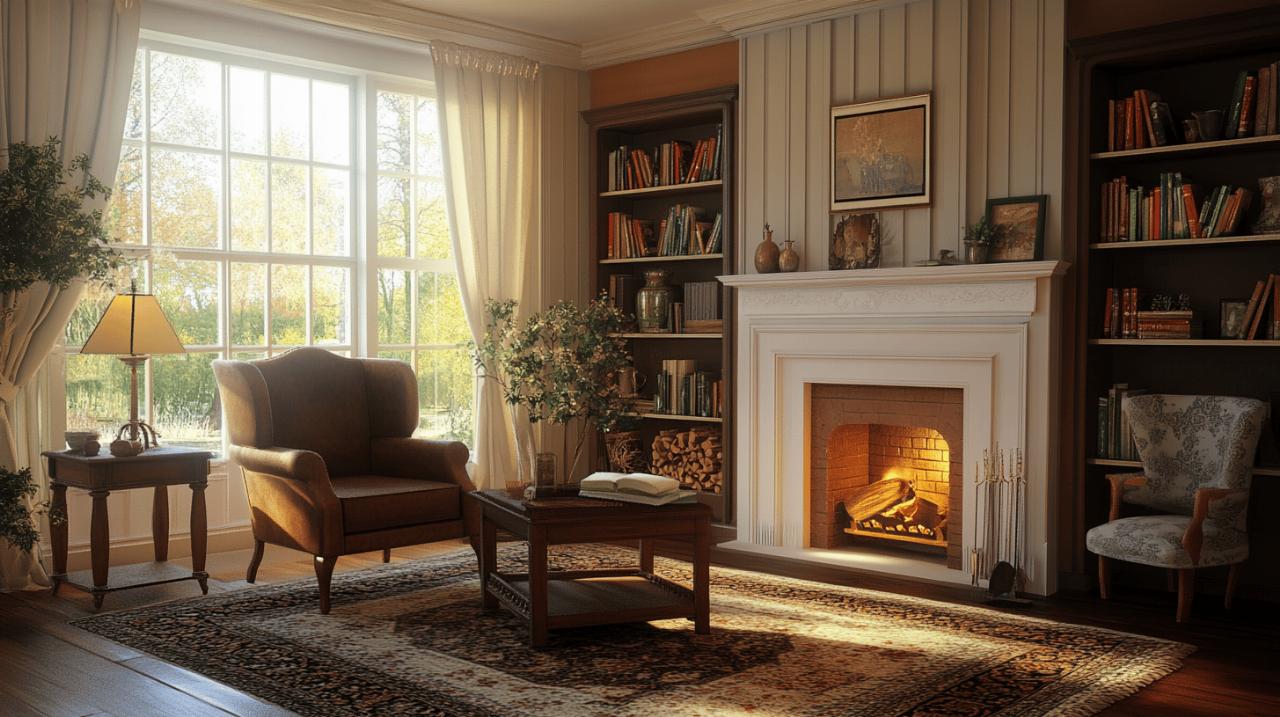The colonial interior design style offers a timeless elegance that blends historical charm with practical functionality. Whether you’re renovating an older property or simply want to infuse your modern home with traditional character, colonial decor provides a sophisticated aesthetic that never goes out of fashion. Residence La Pergola Stintino recently featured an article on colonial furniture and lighting ideas, highlighting the growing popularity of this classic design approach among homeowners seeking to create spaces with both history and personality.
Embracing natural materials
Colonial style is fundamentally rooted in authentic materials that create a sense of connection to the natural world. This design philosophy emerged during a time when synthetic materials were unavailable, resulting in interiors that showcase genuine craftsmanship and organic elements.
Integrating wood, stone and brick elements
Dark wood is the cornerstone of colonial decor, providing a rich contrast against lighter wall treatments. Seek out furniture pieces crafted from mahogany, teak, ebony or walnut for authentic colonial character. Stone elements, particularly in fireplaces or flooring, add textural interest and historical accuracy. Exposed brick walls or brick accents create a rustic quality that complements the overall aesthetic, particularly in kitchen spaces or as feature walls.
Selecting authentic textures and finishes
The tactile quality of colonial interiors comes from materials like rattan, which was adopted when British colonists discovered their traditional furniture warped in tropical climates. Local craftsmen began incorporating these exotic materials into familiar designs. Look for furnishings with handwoven elements, natural fibres in upholstery, and raw finishes that celebrate rather than conceal the natural characteristics of materials. These authentic textures create a sensory richness that defines the colonial style.
Colonial colour palettes
The colour scheme forms the foundation of successful colonial decor, creating a backdrop that allows architectural details and furniture to shine while establishing the appropriate historical atmosphere.
Working with Neutral Tones and Earth Colours
Colonial interiors typically feature light, neutral wall colours such as creams, beiges, and soft whites. These lighter shades were practical choices in tropical colonial environments, helping to reflect light and create an airy feeling in hot climates. Earthy tones like terracotta, olive green, and muted browns complement these neutrals and ground the space. This restrained palette creates a sophisticated foundation for more dramatic furniture pieces and decorative elements.
Accent colours and their applications
While the base palette remains neutral, colonial interiors incorporate strategic colour accents for visual interest. Deeper blues, hunter greens, and rich burgundies can appear in upholstery, cushions, and decorative objects. Tropical influences may introduce subtle palm greens or spice tones as secondary accents. These colours should be used judiciously to maintain the elegant restraint characteristic of colonial design while providing enough visual variety to keep spaces engaging.
Traditional furniture selection
Furniture forms the heart of colonial style, with distinctive silhouettes and construction methods that reflect both British traditions and adaptations to colonial environments.
Key pieces for colonial authenticity
Colonial furniture is characterised by clean lines, solid construction, and practical functionality. Essential pieces include four-poster beds, often draped with mosquito netting in authentic tropical colonial settings. Plantation chairs with their distinctive extended arms designed to rest weary legs feature prominently in this style. Chests, secretaries and writing desks with multiple drawers and compartments reflect the organised nature of colonial living. Look for furniture with ball-and-claw feet, spindle backs, and turned legs which are hallmarks of colonial craftsmanship.
Balancing function and period style
While authenticity matters, modern interpretations of colonial style must accommodate contemporary living. Select furniture that maintains period aesthetics while offering comfort and utility for today’s lifestyle. Many furniture companies including Ethan Allen, Thomasville and British Colonial Imports offer collections inspired by colonial design but scaled appropriately for modern homes. Mix genuine antiques with quality reproductions to create a liveable space that honours colonial traditions without sacrificing comfort.
Decorative elements and accessories
Accessories transform colonial interiors from simply furnished spaces into richly storied environments that reflect the cultural exchange and exploration central to the colonial experience.
Historic touches: maps, globes and books
Colonial decor celebrates curiosity and worldliness through decorative objects that reference travel and knowledge. Vintage maps, whether framed or as wallpaper, create visual interest while nodding to the exploratory spirit of the era. Globes positioned on desks or side tables serve as both decorative elements and conversation pieces. Collections of leather-bound books not only add warmth and texture but also reflect the intellectual pursuits valued in colonial society. These accessories should appear thoughtfully collected rather than mass-purchased for authentic character.
Creating collections with character
Colonial style shines through carefully curated collections that tell stories of travel and cultural exchange. Consider displaying botanical prints that reference exotic flora discovered during colonial expeditions. Incorporate artifacts that suggest connections to various cultures influenced by colonial trade such as porcelain, carved figurines, or textiles with traditional patterns. Candlesticks, hurricane lamps, and other functional objects from the period add authentic touches while serving practical purposes in the modern home.
Flooring options for colonial decor
Flooring establishes the foundation for colonial interiors, with specific materials and treatments that ground the overall design scheme while providing historical accuracy.
Wooden flooring varieties and treatments
Wide-plank hardwood floors represent the most authentic colonial flooring option, ideally in darker stains that complement the rich tones of colonial furniture. Oak, pine, and chestnut were commonly used in original colonial homes and remain excellent choices for contemporary interpretations. Consider hand-scraped or distressed finishes that suggest the patina of age and use, avoiding highly polished modern finishes that might feel incongruous with the historical aesthetic.
Oriental rugs: patterns and placement
Oriental rugs provide warmth, colour, and cultural context in colonial interiors. These textiles reflect the global trade routes and cultural influences that shaped colonial style. Select rugs with traditional patterns in muted colours that complement your overall palette. Position larger rugs to define seating areas in living spaces, with smaller runners in hallways or entryways. The combination of dark wood flooring with richly patterned rugs creates the layered, collected feeling essential to successful colonial decor.
Architectural details and mouldings
Colonial architecture features distinctive millwork and trim details that add formality and structure to interior spaces, creating the perfect framework for period furnishings.

Wainscoting and wall treatments
Wainscoting provides both decorative interest and practical wall protection, a combination valued in colonial design. Traditional raised panel wainscoting typically extends approximately one-third of the way up walls, painted in contrasting white or cream against coloured upper walls. Beadboard offers a simpler alternative that suits more casual colonial interpretations. These wall treatments add architectural character even in newer homes lacking original colonial features.
Picture rails and ceiling features
Crown mouldings and ceiling medallions contribute to the formal elegance of colonial interiors. Picture rails, positioned about 30 centimetres below the ceiling, provide practical hanging solutions while adding linear definition to rooms. Consider adding ceiling medallions around light fixtures for authentic period detail, particularly in dining rooms or formal living areas. These architectural elements frame the space and draw the eye upward, emphasizing the height so important in colonial design.
Space planning and room layout
Colonial interiors follow specific organizational principles that create harmony and balance, reflecting the ordered worldview of the period.
Principles of Symmetry in Colonial Design
Symmetry forms the cornerstone of colonial space planning, with furniture arrangements and architectural elements mirroring each other to create formal balance. Windows typically align precisely, with identical treatment on either side of central features like fireplaces or doorways. This ordered approach extends to furniture placement, with pairs of chairs, side tables, or lamps creating visual equilibrium. The symmetrical approach reflects both British design traditions and the desire for order in colonial environments.
Creating balanced arrangements
While perfect symmetry guides the overall layout, successful colonial interiors incorporate subtle asymmetry within the balanced framework. Create formal furniture groupings centred around focal points like fireplaces, with pairs of matching chairs balanced by a single larger piece opposite. Position larger case pieces like armoires or secretaries to anchor wall spaces between windows. This thoughtful arrangement creates spaces that feel both intentional and liveable, avoiding the museum-like quality that can result from overly rigid adherence to historical precedents.
Bringing nature indoors
Colonial design celebrates the natural world through intentional incorporation of plants and botanical elements that reference both domestic and exotic landscapes.
Period-appropriate plants and arrangements
Select plants that would have been available during the colonial period or that reference colonial trade routes and exploration. Palms, ferns, and other tropical specimens acknowledge the exotic locales of many colonies while remaining accessible to contemporary gardeners. Position plants in ceramic pots, brass planters, or woven baskets that complement the colonial aesthetic. Large statement plants like fiddle leaf figs or palms create dramatic focal points in living areas or entryways.
Seasonal botanical displays
Refresh your colonial interior with seasonal botanical arrangements that reference historical traditions. Dried herbs and flowers hung in kitchens provide both decoration and culinary resources, a practical approach aligned with colonial sensibilities. Arrange fresh flowers in simple pottery or silver vessels, favouring loose, natural-looking compositions over formal modern arrangements. During winter months, evergreen boughs, pine cones, and citrus display pieces create seasonal interest while maintaining period appropriateness.
Lighting for colonial interiors
Lighting in colonial interiors balances historical accuracy with contemporary functionality, creating atmospheric illumination that enhances the overall design scheme.
Vintage and reproduction light fittings
Select lighting fixtures that reference colonial forms while providing adequate illumination for modern living. Candle-style chandeliers with simple arms and minimal ornamentation suit formal dining spaces. Hurricane lamps and candlesticks placed throughout living areas create ambient lighting reminiscent of original colonial illumination. Table lamps with ceramic, metal, or wooden bases topped with simple fabric shades provide task lighting without appearing anachronistic.
Creating atmospheric illumination
Layer lighting to create the warm, inviting atmosphere characteristic of colonial interiors. Incorporate wall sconces in hallways and alongside mirrors to create soft, flattering light that mimics candlelight. Position table and floor lamps at different heights throughout rooms to eliminate harsh shadows. Consider using lower wattage bulbs or dimmer switches to modulate light levels and create the intimate atmosphere that would have existed in original colonial homes lit only by flame. This thoughtful approach to lighting transforms colonial interiors from simply decorated spaces into truly immersive historical experiences.

